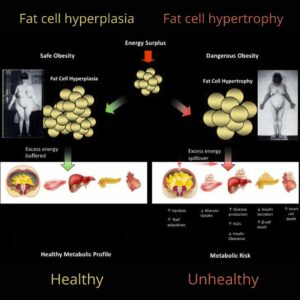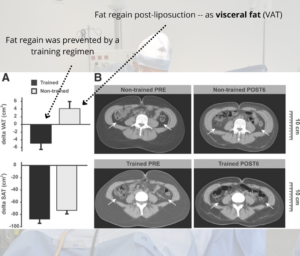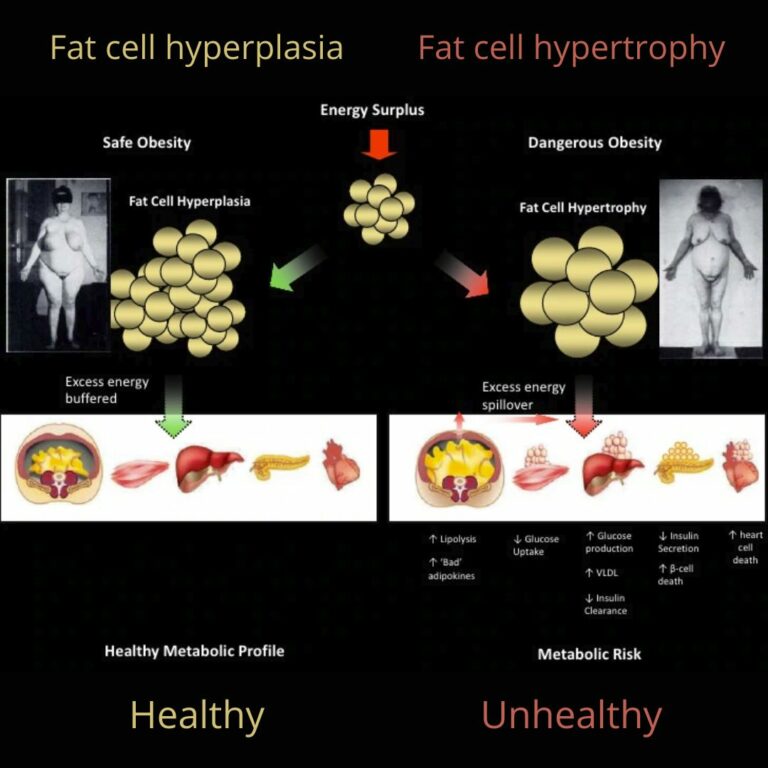Body Fat: The Relevance of Size and Number of Fat Cells
Size vs Number
Obesity is characterized by an excess of adipose (fat) tissue, which can accumulate by 2 different mechanisms.
- Increase the number of fat cells – hyperplasia
- Increase the size of the existing fat cells – hypertrophy
Fat cells are organized in clusters of cells distributed throughout the body – these collections are referred to as depots of fat. For example, common anatomic locations of fat depots are abdominal, femoral, gluteal, etc.
Fixed number of fat cells?
In humans, there is an increase in the number of fat cells in childhood through puberty before leveling off and remaining stable in adulthood. It is believed that, once an adult, the total number of fat cells remains the same, but the fat cells may then increase or decrease in size. Thus, your pool of fat cells is set in your adolescence and is stable for life, whether you gain or lose weight as an adult.
Instead, there appears to be individual variation in the tendency to form new fat cells versus simply enlarge the existing fat cells. One study demonstrated that women with obesity do increase the number of fat cells (hyperplasia) in the subcutaneous fat depot, in addition to also demonstrating enlargement of fat cells (hypertrophy) in both subcutaneous and visceral fat depots.
Also, significant obesity appears to drive an increase in the number of fat cells as well as an increase in the size. The ability to increase the number of fat cells is metabolically more advantageous but associated with higher degrees of obesity.

Variation in size
The size of fat cells varies considerably, with diameters ranging from <20 to 300 micrometers. Within a certain collection (depot) of fat cells, then, there could be a range of several thousand-fold. The variation in size of fat cells is determined primarily by the triglyceride content of the cells.
Sex differences
In women, the relatively larger volume of total body fat is mainly due to higher numbers of fat cells. There is also variation between the sexes in regards to anatomic location of fat. For example, accumulation of femoral (leg) fat in women appears to be due to increased number of fat cells (hyperplasia), whereas in men due to larger fat cells (hypertrophy).
Accumulation of fat in the abdomen in both sexes is due to increased size. Women, however, start with a higher number of fat cells even when lean and thus can accommodate a larger fat mass.
Fat cells in disease
Larger fat cells (more hypertrophic) are less metabolically favorable than smaller cells and are associated with metabolic disease.
Several studies have shown that the size of fat cells correlates with glucose intolerance, with larger cells increasing the risk of type 2 diabetes. In studies of fat accumulation, the increase in fat accumulation appeared to be more predictive of metabolic disease than the size of the cells themselves.
Increased cell size increases the release of inflammatory factors, which is consistent with the finding that higher fat mass creates a state of low-grade inflammation and is associated with chronic disease. Varying size of fat cells also affects the release of several hormonal factors, such as leptin.
It’s believed that the expansion of fat cells causes a change in the membrane stiffness and thus alters signaling of the fat cell.
Decreasing the size of fat cells
Since the number of fat cells in our bodies does not change, the vast majority of fat loss in adults is due to a decrease in the size of the fat cells. This change can be achieved through a myriad of mechanisms such as diet, exercise, surgery, medication, etc.
Reducing the number of fat cells
It appears that the only mechanism of eliminating fat cells is by surgical removal of fat, such as liposuction. While it seems that removing fat would be beneficial, the evidence is not so straightforward.
Animal studies show that surgical removal of fat is followed by regain of the fat within weeks to months. Human studies have shown inconsistent results. One such human study showed that liposuction was followed by a compensatory increase in visceral fat at a 6-month follow-up. It doesn’t appear all bad, though, as that untoward effect could be mitigated by exercise.

In a systematic review in 2017, there were mixed findings regarding the impact of large-volume liposuction on metabolic health. Not surprisingly, liposuction consistently reduced the BMI, but whether that imparts a meaningful benefit versus reducing fat mass by other means remains unknown. In terms of glucose metabolism, 6 of the 10 reviewed studies showed improvement in insulin sensitivity. With inconsistent results and limited evidence, however, liposuction is still considered purely cosmetic.
Summary
The size and number of fat cells have significant bearing on metabolic health. For many, their number of fat cells is fixed prior to adulthood, meaning that fat accumulation or fat loss occurs by a change in the amount of fat within the cells. For others, the ability to increase the number of fat cells appears to be protective against metabolic disease.





